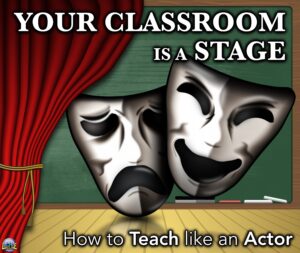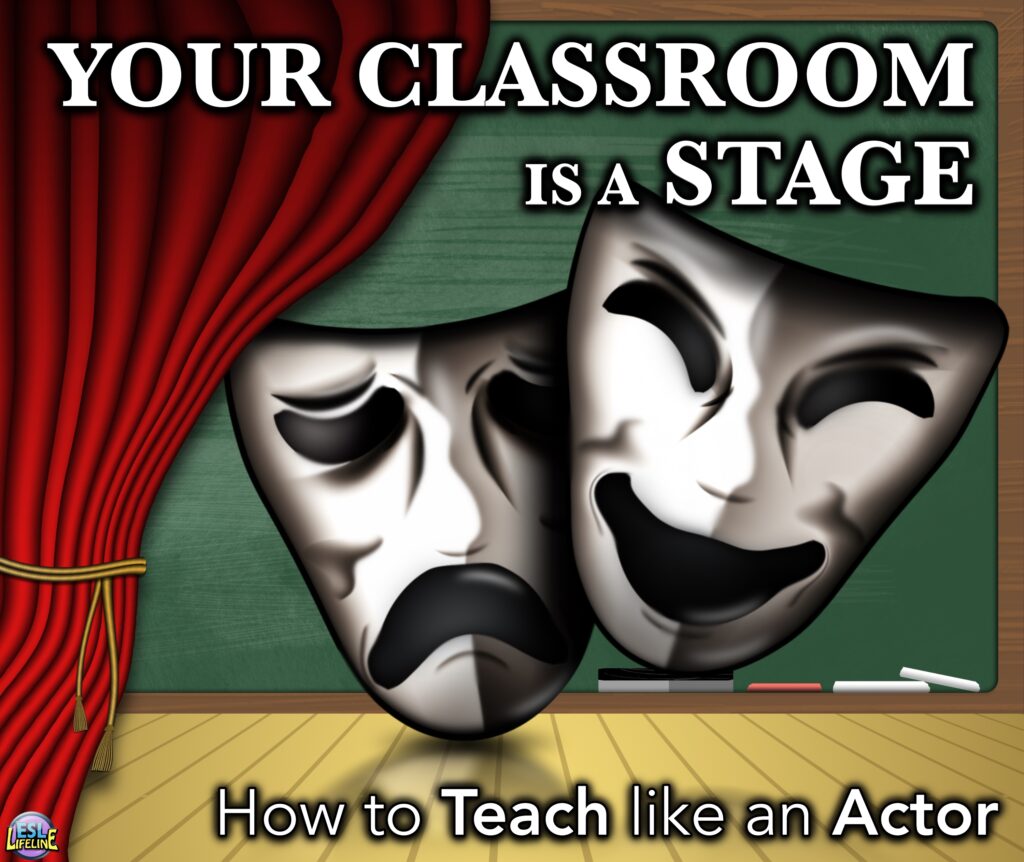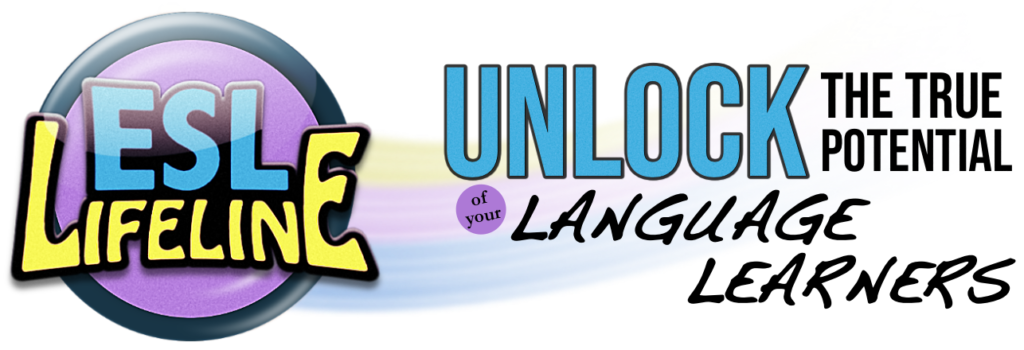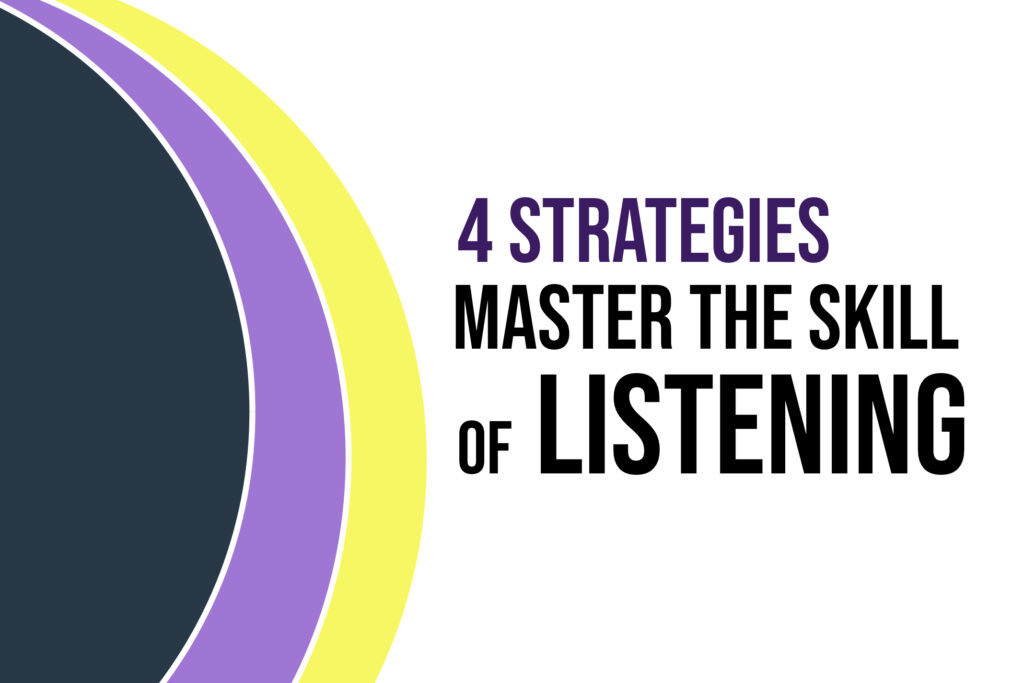
Table of Contents

Interested in access all resources and materials on ESL Lifeline for one low price? Click here to find out how!
Your Classroom is a Stage: How to Teach Like an Actor

Introduction
The best actors aren’t celebrities; they’re teachers. Whether you know it or not, teachers are the unsung heroes of the performance world. While actors are out there basking in standing ovations and shiny awards, teachers are delivering daily monologues, improvising through chaos, and captivating the toughest crowd of all—students. The truth is, teachers and actors have more in common than you might think. And no, it’s not just the caffeine addiction or the ability to cry on cue (we see you during parent-teacher conferences).
Actors prepare for their roles with a mix of dedication, creativity, and a sprinkle of drama. And teachers take a page from this script, too. After all, the classroom is the stage, students are the audience, and every lesson is a chance to bring the house down (metaphorically). In this post, we’ll explore why teachers are the best actors and the steps you can take to channel your inner thespian to make your teaching Oscar-worthy.
Know Your Script – Lesson Planning
Before an actor steps onto the stage or set, they’ve memorized their lines, studied their scenes, and probably Googled “How to cry convincingly in under 10 seconds.” Similarly, you need to know your material inside and out. Sure, you might not have Shakespearean soliloquies to recite, but whether it’s quadratic equations or the causes of World War I, your content needs to be solid.
But here’s the twist: don’t just know your script—own it. Actors don’t just read lines; they interpret them and bring them to life. Do the same with your lesson plans. Add your personality, humor, and flair to them. If you’re teaching fractions, why not turn it into a pizza party? If you’re discussing photosynthesis, channel your inner plant and dramatically “absorb sunlight” in front of the class. The more you embody the material, the more engaged your students will be.
Learn How to Make an Entrance
When I was in the classroom full time, I trained my students to applaud when I walked into the room. I didn’t do this for self-aggrandizement (ok, maybe a little!), but as a way to signal that the curtain was going up and the lesson was starting. This signal cued the students who were less prepared to start and brought them into my world – the world of the lesson.
Think about it: when an actor enters a scene, it’s all about presence. They don’t just shuffle in awkwardly—they command attention. You can do the same in your classroom.
Start each class with a bang: an intriguing question, a funny anecdote, or even a dramatic pause as you stare at your students like you’re about to reveal a life-altering secret (“Today… we’re learning about mitochondria!”). Your entrance sets the tone for the entire lesson, so make it memorable. Bonus points if you can incorporate props or costumes—who wouldn’t love a teacher who shows up wearing a lab coat or Viking helmet?
Warm Up Like a Pro
Actors don’t just roll out of bed and start emoting; they warm up first. Vocal exercises, stretches, and deep breathing are all part of their pre-show ritual. And guess what? You need this too.
Before stepping into the classroom, take a moment to get into character (your character being “The Best Teacher Ever”). Do some tongue twisters to loosen up those vocal cords—“She sells seashells by the seashore” is a classic. Or you could try “Shoulder, Soldier” – something we used to challenge ourselves to say back when I was in acting school. Practice your teacher voice in the mirror: authoritative yet approachable, firm yet fun. And don’t forget to stretch! Nothing says “I’m ready to teach” like a dramatic power pose in the staff lounge.
Play Multiple Roles
Actors often play diverse characters throughout their careers—villains, heroes, comic reliefs—and as a teacher, you’re no different. Some days you’re the wise mentor, guiding students through tough concepts with patience and grace. Other days you’re the strict disciplinarian who doesn’t tolerate gum-chewing or TikTok-ing during class. And let’s not forget your role as the class clown when things need lightening up.
The key is versatility. Don’t be afraid to switch it up depending on what your students need that day. Channel your inner Meryl Streep—if she can convincingly play everything from a fashion mogul to Margaret Thatcher, you can definitely handle teaching geometry and breaking up a lunchtime argument over who gets the last chicken nugget.
Using Props and Designing Sets
Actors rely on props and set design to create an immersive experience for their audience. You can do the same in your classroom! Transform your whiteboard into a canvas for storytelling or use everyday objects to explain complex concepts (cue the classic “two apples minus one apple” math demo).
Better yet, think about how your classroom itself can become part of the learning experience. Rearrange desks into “islands” for group work or decorate your walls with visuals that tie into your lessons. Teaching history? Turn your room into a time machine with posters and artifacts. Teaching literature? Create a cozy book nook that screams “curl up with a classic.” A little creativity goes a long way in making your classroom feel like its own little world.
Happy Accidents: Improvising
Here’s a secret: even the best actors go off-script sometimes. Whether it’s ad-libbing during a live performance or rolling with unexpected changes on set, improvisation is a crucial skill—and it’s one that teachers must master.
When technology fails (looking at you, projector), when students ask questions that derail your carefully planned lesson (“But why do we even need math?”), or when someone lets out an ill-timed sneeze that sends the whole class into giggles—you’ve got to think on your feet. The best way to do this is to remember to “Never negate”, and that there is more than one way to say “No”. Keep the class positive, start thinking in terms of progressing the scene (lesson) forward, and embrace these moments as opportunities to connect with your students. This will show them that learning doesn’t have to be rigid or perfect. Sometimes the best lessons come from happy accidents!
Leave them Wanting More
Great actors know how to end on a high note—whether it’s delivering a killer closing line or leaving audiences in tears (the good kind). You should aim for the same with your lessons. Wrap up each class with a memorable takeaway: a thought-provoking question, a quick recap game, or even just a heartfelt “You crushed it today!”
Your goal is to leave students excited for what’s coming next. If they walk out of your classroom humming “The mitochondria is the powerhouse of the cell” like it’s their new favorite song, congratulations—you’ve nailed it.
Conclusion
So, there you have it. The best actors are not celebrities; they are teachers. At the end of the day, teaching is both an art and a performance. By adopting some tried-and-true methods from actors, you can elevate your classroom game and create an environment where learning feels exciting, dynamic, and maybe even a little magical.
So go ahead—step into the spotlight, deliver those Oscar-worthy lessons, and watch as your students become your most loyal fans (or at least stop pretending to be asleep during class). Break a leg out there, teacher—you’ve got this!
UNLIMITED DOWNLOADS
Interested in learning how you can transform your instruction and get your prep-time back??





